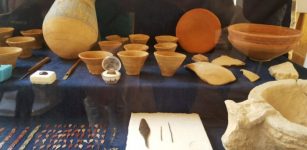Sarmizegetusa And Its Andesite Sun Artifact Similar To The Mayan Calendar
A. Sutherland - AncientPages.com - Sarmizegetusa (today Gradistea Muncelului) County was the capital of pre-Roman Dacia, located in the Orastie Mountains, in present-day Romania. Before the wars with the Roman Empire, Sarmizegetusa was also the most important military, religious and political center of the Dacians.
It's a complex of sanctuaries situated on a cliff at an altitude of 1200 m, with a leading, large round sanctuary and the so-called "andesite sun" artifact.
The sanctuaries were located on a terrace, which had been linked previously mentioned gate by a paved road. Today, it's unknown if Sarmizegetusa had seven or eight quadrilateral sanctuaries because the Romans destroyed them
The fortress, a strategic center of defense, has a quadrilateral (a four-sided polygon) shape and massive stone blocks with 3m thick and approximately 4-5m high walls, constructed on five terraces, an area of almost 30,000 m².
The sacred zone of Sarmizegetusa includes several rectangular temples, and the bases of their supporting columns are still visible in regular arrays.
Perhaps the most enigmatic construction at the site is the large circular sanctuary. It consisted of a set of timber posts surrounded by a timber circle which in turn was surrounded by a low stone curb.
The andesite sun and the great round sanctuary from Sarmizegetusa Regia. (photo from The cultural Heritage of Romania, (Cluj-Napoca, 2004)
The layout of the timber settings of the Sarmizegetusa fortress bears an intriguing resemblance to the stone monument at Stonehenge in England.
We find another curious resemblance at Sarmizegetusa's most crucial artifact, "andesite sun," which was probably used as a sundial. The artifact is very similar to the famous Mayan calendar. The Dacian culture was influenced by contact with Hellenistic Greece. The sundial may have resulted from the Dacians' exposure to Hellenistic learning in geometry and astronomy. The capital of Dacia was conquered and destroyed by the Roman army in 106 AD.
Its ruins were unearthed for the first time in 1923 due to excavations under the leadership of prof. DM Teodorescu of the Department of Archaeology, the University of Cluj-Napoca, followed by other diggings until 1944.
Since it is known that Dacian culture was influenced by contact with Hellenistic Greece, the sundial may have resulted from the Dacians’ exposure to Hellenistic learning in geometry and astronomy.
Sarmizegetusa Regia also had a residential area of 3 km, with dwellings and workshops. It was a vast civil settlement with many homes, workshops, warehouses, barns, and a water reservoir.
People lived below the citadel in settlements built on artificial terraces and a system of ceramic pipes channeled running water into the nobility's residences. The archaeological inventory found at the site demonstrates that Dacian society had a relatively high standard of living.
At 100 meters to the east of the complex, there was the city and shrines of various shapes and sizes. The sanctuaries were located on a terrace linked with the gate by a paved road. Today, it's unknown if Sarmizegetusa had seven or eight quadrilateral sanctuaries because the Romans destroyed them.
The mathematical pattern of Sarmisegetusa includes all cyclopean buildings of the Dacians built at an altitude of 1,045m). The line of the North coincides precisely with the arrow of the so-called Andesite Sun.
At the ancient site of Sarmizegetusa, we encounter evidence of our ancestors' knowledge of cosmogonical topography, divine geometry, and cosmic harmony and several artifacts offering proof that the Dacians were an advanced society.
The Dacians were skilled metalworkers. Excavations conducted in the area revealed tools such as meter-long tongs, hammers, and anvils used to make 400 metallic artifacts — scythes, sickles, hoes, rakes, picks, pruning hooks, knives, plowshares, and carpenters' tools.
Decebalus’ suicide, from Trajan’s Column (Scene CXLV)
However, among the most important finds unearthed at the site, is a medical kit, in a brassbound wooden box with an iron handle, containing a scalpel, tweezers, powdered pumice and miniature pots for pharmaceuticals, and a large funerary vessel (0.6 m) high and 41 in (1 m) across, bearing an inscription in the Roman alphabet: DECEBAL PER SCORILO, i.e. 'Decebalus, son (cf. Latin puer) of Scorilus'.
The Decebalus per Scorilo inscription. The Decebalus inscription was stamped on a huge vase twenty-four inches (0.6 meters) high and forty-one inches (1 meter) across. It is stamped in mirror-writing, in the Latin alphabet. image source
Decebal (Decebalus) (ruled 87-106) was the last king of Dacia. The Romans defeated the Dacians in the Battle of Tapae in 88; they set fire to several towns and moved towards Sarmizegetusa, the kingdom's capital.
The Romans laid siege to the town and cut Sarmizegetusa's water supply. The Dacians eventually surrendered, and Decebalus committed suicide. Dacia became a Roman province.
Dacian Fortress Sarmizegetusa is on the UNESCO World Heritage list.
Written by – A. Sutherland - AncientPages.com Senior Staff Writer
Copyright © AncientPages.com All rights reserved. This material may not be published, broadcast, rewritten or redistributed in whole or part without the express written permission of AncientPages.com
Expand for referencesReferences:
I. Grumeza, "Dacia: Land of Transylvania, Cornerstone of Ancient Eastern Europe"
More From Ancient Pages
-
 Orichalcum: Mysterious Metal Linked To Legendary Atlantis Discovered In Shipwreck
Archaeology | Jan 8, 2015
Orichalcum: Mysterious Metal Linked To Legendary Atlantis Discovered In Shipwreck
Archaeology | Jan 8, 2015 -
 Where Were Herod The Great’s Royal Alabaster Bathtubs Quarried?
Archaeology | May 17, 2022
Where Were Herod The Great’s Royal Alabaster Bathtubs Quarried?
Archaeology | May 17, 2022 -
 Din Lligwy: Prehistoric Celtic Settlement Of Anglesey, Wales
Featured Stories | Dec 3, 2022
Din Lligwy: Prehistoric Celtic Settlement Of Anglesey, Wales
Featured Stories | Dec 3, 2022 -
 Curse Of The Scottish Fyvie Castle That Survived Generations
Featured Stories | May 5, 2020
Curse Of The Scottish Fyvie Castle That Survived Generations
Featured Stories | May 5, 2020 -
 Baby Carriers Were Used 10,000 Years Ago – New Evidence
Archaeology | Sep 27, 2022
Baby Carriers Were Used 10,000 Years Ago – New Evidence
Archaeology | Sep 27, 2022 -
 Was Princess Tadukhipa Of The Mitanni Kingdom Queen Nefertiti?
Civilizations | Mar 15, 2016
Was Princess Tadukhipa Of The Mitanni Kingdom Queen Nefertiti?
Civilizations | Mar 15, 2016 -
 Makhunik – 5,000-Year-Old City Of Dwarfs Who Hoped To Return One Day
Civilizations | May 28, 2014
Makhunik – 5,000-Year-Old City Of Dwarfs Who Hoped To Return One Day
Civilizations | May 28, 2014 -
 Curse Of The Dancer – Mysterious 1,500-Year-Old Tablet Finally Deciphered
Archaeology | Oct 14, 2019
Curse Of The Dancer – Mysterious 1,500-Year-Old Tablet Finally Deciphered
Archaeology | Oct 14, 2019 -
 Homo Sapiens In China And What Happened When They Encountered Denisovans Or Neanderthals
Archaeology | Mar 4, 2022
Homo Sapiens In China And What Happened When They Encountered Denisovans Or Neanderthals
Archaeology | Mar 4, 2022 -
 Groundbreaking Study: First Known Case Of Down Syndrome In Neanderthals – Investigated
Archaeology | Jun 28, 2024
Groundbreaking Study: First Known Case Of Down Syndrome In Neanderthals – Investigated
Archaeology | Jun 28, 2024 -
 New Dating Of Intriguing Cave Art Reveals History Of Puerto Rican People
Archaeology | Oct 19, 2023
New Dating Of Intriguing Cave Art Reveals History Of Puerto Rican People
Archaeology | Oct 19, 2023 -
 New Discoveries In the Valley Of The Monkeys In Luxor, Egypt
Archaeology | Oct 11, 2019
New Discoveries In the Valley Of The Monkeys In Luxor, Egypt
Archaeology | Oct 11, 2019 -
 A Remarkable Curse Tablet Dated To the 1st Century AD – Unearthed In Tongeren
Archaeology | Jul 10, 2020
A Remarkable Curse Tablet Dated To the 1st Century AD – Unearthed In Tongeren
Archaeology | Jul 10, 2020 -
 On This Day In History: Stone Of Destiny Stolen From Westminster Abbey In London – On Dec 25, 1950
News | Dec 25, 2016
On This Day In History: Stone Of Destiny Stolen From Westminster Abbey In London – On Dec 25, 1950
News | Dec 25, 2016 -
 Largest Ever Recorded Ancient Petroglyphs Found In Venezuela – Mapped
Archaeology | Dec 10, 2017
Largest Ever Recorded Ancient Petroglyphs Found In Venezuela – Mapped
Archaeology | Dec 10, 2017 -
 First Settlers Of Ancient Peru Left Behind 12,000-Year-Old Stone Objects
Archaeology | Mar 16, 2018
First Settlers Of Ancient Peru Left Behind 12,000-Year-Old Stone Objects
Archaeology | Mar 16, 2018 -
 Mystery Of The Hunza People: Did They Really Live To 145 Years Of Age?
Civilizations | Jul 5, 2018
Mystery Of The Hunza People: Did They Really Live To 145 Years Of Age?
Civilizations | Jul 5, 2018 -
 Ice Mummies Of Pazyryk Culture In Siberia Had Complex Tattoos On Their Bodies
Archaeology | Jul 31, 2025
Ice Mummies Of Pazyryk Culture In Siberia Had Complex Tattoos On Their Bodies
Archaeology | Jul 31, 2025 -
 Skull Of Biblical Giant Goliath Is Buried On The Hill Golgotha In Jerusalem – New Claim
Archaeology | Nov 7, 2019
Skull Of Biblical Giant Goliath Is Buried On The Hill Golgotha In Jerusalem – New Claim
Archaeology | Nov 7, 2019 -
 1,700-Year-Old Statue OF Greek God Pan Unearthed In Istanbul
Archaeology | Jun 9, 2023
1,700-Year-Old Statue OF Greek God Pan Unearthed In Istanbul
Archaeology | Jun 9, 2023






